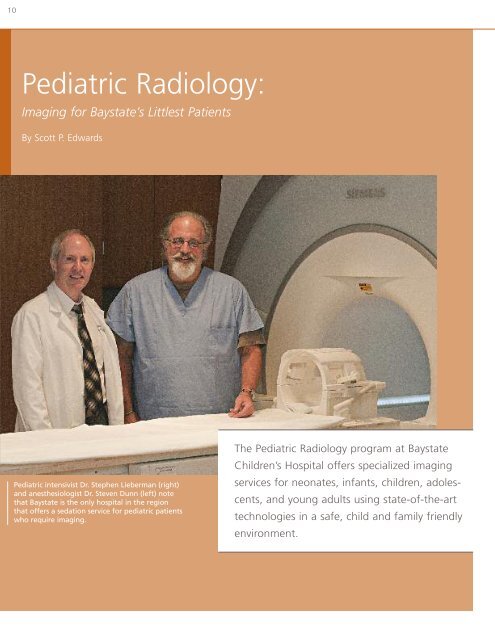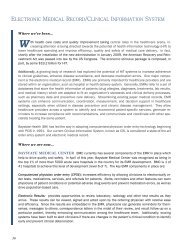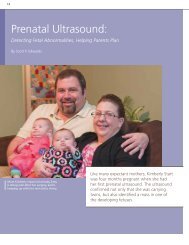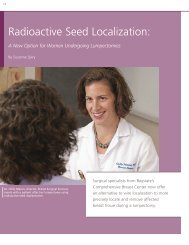Pediatric Radiology: - Baystate Health
Pediatric Radiology: - Baystate Health
Pediatric Radiology: - Baystate Health
Create successful ePaper yourself
Turn your PDF publications into a flip-book with our unique Google optimized e-Paper software.
10<strong>Pediatric</strong> <strong>Radiology</strong>:Imaging for <strong>Baystate</strong>’s Littlest PatientsBy Scott P. Edwards<strong>Pediatric</strong> intensivist Dr. Stephen Lieberman (right)and anesthesiologist Dr. Steven Dunn (left) notethat <strong>Baystate</strong> is the only hospital in the regionthat offers a sedation service for pediatric patientswho require imaging.The <strong>Pediatric</strong> <strong>Radiology</strong> program at <strong>Baystate</strong>Children’s Hospital offers specialized imagingservices for neonates, infants, children, adolescents,and young adults using state-of-the-arttechnologies in a safe, child and family friendlyenvironment.
11The program offers the full gamut of imaging studies andimage guided pediatric care including standard X-rays,fluoroscopy, ultrasound, CT, and MRI. The studies aresupervised, performed, and interpreted by radiologistswith subspecialty training.<strong>Pediatric</strong> radiologists are experts in selecting the bestimaging techniques to diagnose medical and surgicalproblems in infants and children. They are available asconsultants to guide the imaging algorithm and recommendnon-radiation examinations, when appropriate.The pediatric radiologists ensure that the testing isperformed properly and safely so that an accuratediagnosis can be made.<strong>Baystate</strong>’s <strong>Pediatric</strong> <strong>Radiology</strong> program is a subspecialtywithin the Department of <strong>Radiology</strong>. The bright colors andtoys in the pediatric waiting room provide comfort forchildren and their families. The exam rooms are staffed bya dedicated group of radiology technologists who create asafe, family friendly environment. Nurses and Child Lifespecialists are also key members of the team. No otherhospital in the region provides this level and range ofsubspecialized care. Three unique initiatives make<strong>Baystate</strong>’s <strong>Pediatric</strong> <strong>Radiology</strong> program further stand out:sedation, fetal MRI, and “image gently.”SedationBecause most children, especially very young ones, areunable to hold still for the 15 to 90 minutes it takes tocomplete an MRI and other imaging studies, many ofthem receive moderate sedation to decrease their movementso the scan can be completed.“The program started when, rather quickly, there becamean increasing number of children who required some typeof medication for a variety of imaging procedures,” saysStephen Lieberman, MD, the pediatric intensivist whostarted the program. Between 800 to 900 procedures willbe performed this year at <strong>Baystate</strong> Children’s Hospital.While many children undergoing imaging studies can besedated, others need to be completely unconscious inorder to remain still. “Similar to when anyone has surgery,we have a system in place to screen pediatric patients andprepare them for anesthesia,” says Steven Dunn, MD,interim chair of <strong>Baystate</strong>’s Department of Anesthesiology.“Many other places don’t offer this service because it islabor intensive, and they might not have enough anesthesiologistswho are completely comfortable caring for smallchildren.”<strong>Pediatric</strong> intensivists provide moderate sedation for a varietyof procedures, including interventional radiology(PICC lines, feeding tubes, arteriograms); CT scan-guidedremoval of fluid from the chest, abdomen, and surroundingthe heart; MRIs; ultrasound-guided biopsies of thekidney and liver; gastrointestinal endoscopies, bronchoscopies,spinal taps, and bone marrow biopsies; and voidingcystourethrograms.<strong>Pediatric</strong> radiologists (left to right) Drs. Stephen O’Connor,Tara Catanzano, and Stanley Polansky offer comprehensiveimaging studies and image guided pediatric care includingstandard X-rays, fluoroscopy, ultrasound, CT, and MRI.A combined program to support <strong>Pediatric</strong> <strong>Radiology</strong>services was developed with <strong>Baystate</strong>’s pediatric anesthesiologistsand pediatric intensivists. The pediatric anesthesiologistsand nurse anesthetists from the Department ofAnesthesiology manage infants and children with complexmedical problems and the need for general anesthesia tocomplete their MRI studies. Cases requiring moderatesedation are supported by the pediatric intensivists whoare experienced with the medications used for sedationas they are widely used in <strong>Baystate</strong>’s <strong>Pediatric</strong> IntensiveCare Unit.
12In addition to Dr. Lieberman, pediatric intensivistsChristine McKiernan, MD, and Michael Canarie, MD,are part of the program, as well as Rebecca Blanchard,RN, who assists with the large volume of MRIs thatrequire sedation.“We are the only hospital in the area to offer this servicebecause <strong>Baystate</strong> Children’s Hospital is the only institutionin Western Massachusetts with the expertise to doit safely, especially the nursing personnel who place theIVs and monitor the children,” says Dr. Lieberman.Fetal MRI<strong>Baystate</strong> Medical Center is also the only institution inWestern Massachusetts that offers fetal MRI. StephenO’Connor, MD, pediatric radiologist, has primaryresponsibility for this service. “Fetal MRI is a powerfultool that can expand and confirm information obtainedfrom the high quality ultrasounds performed by ourcolleagues in Maternal Fetal Medicine. It allows us tofurther investigate potentially serious fetal anomalies inthe brain, spine, thorax, and abdomen without the useof sedation or radiation.”Unique to fetal MRIs, Dr. O’Connor says he actually sitsat the console with the MRI technologist so that theimages can be obtained quickly to account for fetalmotion. “This makes it especially challenging,” he says.“When we see certain anomalies on ultrasound in eitherthe fetus or the mother,” says <strong>Baystate</strong> Maternal/FetalMedicine specialist Fadi Bsat, MD, “MRI can help. Itcan also be helpful in conditions that could change themanagement of the pregnancy or in preparation forpossible complications at delivery.”Dr. Bsat says fetal MRIs are most often used at <strong>Baystate</strong>for fetal central nervous system abnormalities or fetalchest or neck masses. For example, ultrasound may notbe able to determine if a baby with a chest mass will beable to breathe after delivery, but MRI can tell physiciansif the baby’s lungs may be compromised and intubationor other interventions are required at delivery.Dr. O’Connor adds, “The push to add fetal MRI at<strong>Baystate</strong> came from a group of specialists includingpediatric surgeons, geneticists, neonatologists, andmaternal fetal specialists, who approached us because atthe time, the closest place offering fetal MRI was inBoston. Traveling that far was often a hardship forpatients, so offering this subspecialty locally is atremendous benefit for patients, making it much morelikely they’ll stay with <strong>Baystate</strong> for the remainder oftheir pre- and post-natal care. It also offers positiveimplications for our graduate medical education programsin obstetrics/gynecology, surgery, pediatrics, anesthesiology,and radiology.”Maternal Fetal Medicine specialistDr. Fadi Bsat says fetal MRIs aremost often used at <strong>Baystate</strong> forfetal central nervous systemabnormalities or fetal chest orneck masses.
13MRI is also used for the health of the mother, especiallyin trauma cases in which the mother’s abdomen orpelvis is involved and for whom X-ray or CT scan maybe associated with some fetal risks. It can also helpdetect problems such as placenta accreta, a severeobstetric complication involving strong attachment ofthe placenta to the uterine wall, which can cause severebleeding with detachment.Image GentlyRadiation exposure, including medical radiation, is aconcern for both adults and children. This is particularlyimportant in children since their tissues are moreradiosensitive. Children have a longer lifetime in whichto manifest radiation-induced injury. Each examinationshould be considered cumulative and therefore morelikely to result in adverse health effects.<strong>Baystate</strong>’s <strong>Pediatric</strong> <strong>Radiology</strong> program has been activefor years in efforts to reduce medical radiation in children.This goal is fostered through a long-term involvementin the Society for <strong>Pediatric</strong> <strong>Radiology</strong> and, since2006, in the Alliance for Radiation Safety in <strong>Pediatric</strong>Imaging. <strong>Baystate</strong>’s program has participated in thenational “image gently” campaign since its inception.The motivating principle is to change medical and radiologypractice by increasing awareness of the opportunitiesto lower radiation doses when imaging children.“At <strong>Baystate</strong>, we respect the fact that children are moresusceptible to radiation problems than adults,” saysStanley Polansky, MD, chief of <strong>Pediatric</strong> <strong>Radiology</strong>, “sowe use the lowest possible levels of radiation. We tookthe pledge to ‘image gently,’ and we adhere to the principlesexpounded by the Alliance.”same procedure on an adult. The potential benefit froman indicated CT examination is clinically recognizedand documented and is far greater than the potentialcancer risk.”In addition, Dr. Polansky and his colleagues Drs.Stephen O’Connor and Tara Catanzano, serve asresources for referring physicians and patients’ families.They offer advice about what imaging procedures areappropriate and what imaging alternatives are availablethat do not use radiation.“The role of the pediatric radiologist is multifold,” saysDr. Polansky. “It is to understand radiation doses;review requests for higher dose studies; discuss caseswith clinicians; use appropriate technical factors; helpspread current knowledge about radiation doses; trainmedical students, residents, and radiology technologists;educate health care providers; and participate inProfessional Quality Improvement programs.”“Our pediatric radiologists do not fit the profile of atypical ‘adult’ radiologist,” says Laurie Gianturco, MD,chair of <strong>Radiology</strong> at <strong>Baystate</strong> Medical Center. “Theyspend a lot of time working closely with patients andtheir families, and the pediatricians and surgeons at<strong>Baystate</strong> and in the community.”Dr. Polansky concludes, “When a child is referred tous, their family can feel secure that they are going toa center that provides special attention to children,offers a safe and friendly environment, accomplishesimaging exams with high degrees of success, andadheres to principles for using the least amountof radiation possible.”With the help of medical physicist M. Terry LaFrance,<strong>Baystate</strong>’s pediatric radiologists follow the ALARA (AsLow As Reasonably Achievable) principle of radiationsafety, scaling back radiation doses for children.“This is a dynamic process with constant monitoring oftechniques to further cut back radiation exposure, particularlyin CT,” says Dr. Polansky. “In general, properlyperformed CT examinations of children should exposea child to much lower exposures than those for theRefer a Patient<strong>Baystate</strong> Children’s Hospital759 Chestnut StreetSpringfield, Massachusetts413-794-2222
















